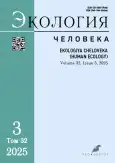Взаимосвязь потребления пищевых продуктов животного происхождения и микробиоты кишечника
- Авторы: Ермолаев А.В.1,2, Лямин А.В.1, Горбачев Д.О.1
-
Учреждения:
- Самарский государственный медицинский университет
- 1026 центр государственного санитарно-эпидемиологического надзора военного округа
- Выпуск: Том 32, № 3 (2025)
- Страницы: 195-206
- Раздел: ОРИГИНАЛЬНЫЕ ИССЛЕДОВАНИЯ
- URL: https://journal-vniispk.ru/1728-0869/article/view/314582
- DOI: https://doi.org/10.17816/humeco642725
- EDN: https://elibrary.ru/YIPDKR
- ID: 314582
Цитировать
Полный текст
Аннотация
Обоснование. В современном мире питание играет ключевую роль в поддержании здоровья и благополучия человека. Однако неправильное питание и несбалансированный рацион могут привести к развитию различных алиментарно-зависимых заболеваний. В условиях организованного закрытого коллектива, где питание часто стандартизировано и ограничено, риск развития алиментарно-зависимых заболеваний возрастает. Недостаток разнообразия в рационе, низкое качество продуктов и отсутствие контроля над потреблением могут способствовать возникновению острых инфекционных и хронических заболеваний.
Цель. Оценить особенности микробиоты кишечника в зависимости от характеристики потребления пищевых продуктов животного происхождения.
Методы. В исследовании приняли участие 120 представителей мужского пола, которые были объединены в строго организованную группу с ограниченным доступом (коллектив закрытого типа). Была проведена оценка фактического питания участников на основе метода 24-часового воспроизведения суточного рациона. Микробиоту кишечника исследовали культуральным методом с применением расширенного набора питательных сред и идентификацией всех выделенных микроорганизмов с помощью MALDI-ToF масс-спектрометрии. Статистический анализ проводили с использованием специального программного обеспечения стандартного пакета StatTech v.4.2.6.
Результаты. При употреблении молока и молочных продуктов достоверно чаще были выделены Salmonella spp., яичных продуктов — Agromyces spp., Geobacillus spp., Roseomonas spp., мясных продуктов — Lactococcus spp., рыбных продуктов — Limosilactobacillus spp., Salmonella spp., Micrococcus spp., масел животного происхождения — Klebsiella spp., Lactococcus spp.
Заключение. Результаты проведённого исследования выявили ряд особенностей состава микробиоты при употреблении отдельных пищевых продуктов животного происхождения. Установлены статистически значимые корреляционные связи между употреблением готовых мясных и рыбных блюд и выделением Lactococcus spp., Limosilactobacillus spp., Salmonella spp., Micrococcus spp. Обозначена взаимосвязь между потреблением молочных и яичных продуктов питания и выделением Salmonella spp., Agromyces spp., Geobacillus spp., Roseomonas spp.
Ключевые слова
Полный текст
Открыть статью на сайте журналаОб авторах
Александр Вадимович Ермолаев
Самарский государственный медицинский университет; 1026 центр государственного санитарно-эпидемиологического надзора военного округа
Автор, ответственный за переписку.
Email: a.v.ermolaev@samsmu.ru
ORCID iD: 0000-0003-4044-9139
SPIN-код: 1541-8495
Россия, Самара; Самара
Артем Викторович Лямин
Самарский государственный медицинский университет
Email: a.v.lyamin@samsmu.ru
ORCID iD: 0000-0002-5905-1895
SPIN-код: 6607-8990
д-р мед. наук, доцент
Россия, СамараДмитрий Олегович Горбачев
Самарский государственный медицинский университет
Email: d.o.gorbachev@samsmu.ru
ORCID iD: 0000-0002-8044-9806
SPIN-код: 1276-2740
д-р мед. наук, доцент
Россия, СамараСписок литературы
- Tutelyan VA, Vyalkov AI, Razumov AN. The science of healthy eating. Moscow: Panorama; 2010. 839 р. (In Russ.) EDN: TFKGHH
- Tutelyan VA, Nikityuk DB. Key challenges in the dietary intake structure and cutting edge technologies for optimizing nutrition to protect the health of the Russian рopulation. Problems of Nutrition. 2024;93(1):6–21. doi: 10.33029/0042-8833-2024-93-1-6-21 EDN: XCDQZJ
- Kiprushkina EI, Kolodyaznaya VS, Filippov VI, et al. The importance of nutrition in the forming of intestinal microbiome. Journal of International Academy of Refrigeration. 2020;(2):52–59. doi: 10.17586/1606-4313-2020-19-2-52-59 EDN: JFZYEJ
- Stoma IO. Microbiome in medicine: a guide for doctors. Moscow: GEOTAR-Media; 2020. 319 р. (In Russ.) ISBN: 978-5-9704-5844-0
- Nikonova EL, Popova EN, editors. Microbiota. Moscow: Media Sfera; 2019. 256 р. (In Russ.) ISBN: 978-5-89084-058-5
- Bragina TV, Sheveleva SA, Elizarova EV, et al. The structure of blood gut microbiota markers in athletes and their relationship with the diet. Problems of Nutrition. 2022;91(4):35–46. doi: 10.33029/0042-8833-2022-91-4-35-46 EDN: HXIFIJ
- Markova YuM, Sidorova YuS. Amaranth, quinoa and buckwheat grain products: role in human nutrition and maintenance of the intestinal microbiome. Problems of Nutrition. 2022;91(6):17–29. doi: 10.33029/0042-8833-2022-91-6-17-29 EDN: YQIQFY
- Kontareva VYu, Kryuchkova VV. Influence of the enriched kefir products on enterobakteria development. Food Processing: Techniques and Technology. 2017;(4):54–59. doi: 10.21603/2074-9414-2017-4-54-59 EDN: VZJRZB
- Hoffmann V, Simiyu S, Sewell DK, et al. Milk product safety and household food hygiene influence bacterial contamination of infant food in Peri-Urban Kenya. Front Public Health. 2022;9:772892. doi: 10.3389/fpubh.2021.772892
- Zhan Y, Yong-Jiang X, Yuanfa L. Influences of dietary oils and fats, and the accompanied minor content of components on the gut microbiota and gut inflammation: A review. Trends in Food Science & Technology. 2021;113:255–276. doi: 10.1016/j.tifs.2021.05.001
- Viteri-Echeverría J, Calvo-Lerma J, Ferriz-Jordán M, et al. Association between dietary intake and faecal microbiota in children with cystic fibrosis. Nutrients. 2023;15(24):5013. doi: 10.3390/nu15245013
- Syromyatnikov MY, Kokina AV, Solodskikh SA, et al. High-Throughput 16S rRNA gene sequencing of butter microbiota reveals a variety of opportunistic pathogens. Foods (Basel, Switzerland). 2020;9(5):608. doi: 10.3390/foods9050608
- Liu X, Shao Y, Sun J, et al. Egg consumption improves vascular and gut microbiota function without increasing inflammatory, metabolic, and oxidative stress markers. Food Sci Nutr. 2021;10 (1):295–304. doi: 10.1002/fsn3.2671
- Barakat RK, Griffiths MW, Harris LJ. Isolation and characterization of Carnobacterium, Lactococcus, and Enterococcus spp. from cooked, modified atmosphere packaged, refrigerated, poultry meat. Int J Food Microbiol. 2000;62(1-2):83–94. doi: 10.1016/S0168-1605(00)00381-0
- Settier-Ramírez L, López-Carballo G, Gavara R, et al. Evaluation of Lactococcus lactis subsp. lactis as protective culture for active packaging of non-fermented foods: creamy mushroom soup and sliced cooked ham. Food Control. 2021;122(3):107802. doi: 10.1016/j.foodcont.2020.107802
- Okyere A, Bishoff D, Oyaro MO, et al. Analysis of fish commonly sold in local supermarkets reveals the presence of pathogenic and multidrug-resistant bacterial communities. Microbiology Insights. 2018;11:1178636118786925. doi: 10.1177/1178636118786925
- Shang Q, Li Q, Zhang M, et al. Dietary Keratan Sulfate from shark cartilage modulates gut microbiota and increases the abundance of Lactobacillus spp. Mar Drugs. 2016;14(12):224. doi: 10.3390/md14120224
- Belleggia L, Osimani A. Fermented fish and fermented fish-based products, an ever-growing source of microbial diversity: a literature review. Food Res Int. 2023;172:113112. doi: 10.1016/j.foodres.2023.113112
- Tacconi E, Palma G, De Biase D, et al. Microbiota effect on trimethylamine n-oxide production: from cancer to fitness — a practical preventing recommendation and therapies. Nutrients. 2023;15(3):563. doi: 10.3390/nu15030563
Дополнительные файлы








